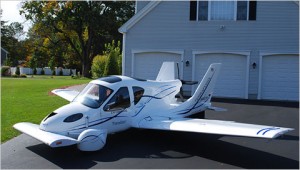The Rise of the Flying Car
We take for granted our ability to drive hundreds of miles in just a few hours time. We don’t think twice about being able to stand on two different continents in the same day. For thousands of years, we were limited to where we could walk. For hundreds of years, we were limited to where we could float. It’s only in the last 100 years, the blink of an eye, that the automobile and airplane have enabled us to span the globe. The evolution of travel will continue into the future, and we are nearing a new step in that process.
The average speed for cars in the U.S. is 35 mph. In densely populated cities like Los Angeles, this figure is even lower. The U.S. Department of Transportation estimates that 6.7 billion gallons of gasoline are wasted in traffic jams each year. Flying cars have a practical use in today’s world. Helicopters aren’t cheap, and their top end speed is fairly limited. The flying car would find a necessary home with ambulances, police and emergency services, and within the military.
The first flying car was actually built in 1937. It could fly at 110 mph and drive at 55 mph. In a 1950′s feasibility study, Ford Motor Company concluded that a flying car product was technically feasible, economically manufacturable, and had significant realistic markets. The main problem with the Federal Aviation Administration (FAA) at that time was that the air traffic control systems were inadequate for the increase in traffic.
In the 21st century, there are numerous companies attempting to make a commercially viable flying car. The leader in the clubhouse is a company called Terrafugia. They have been working on what’s referred to as a ‘roadable aircraft’ since 2006. They are nearing the final stages, and will actually be demoing the final product next month. The Terrafugia Transition has wings that quickly fold up to make it compact enough to be driven on roads.
While it won’t be legal to take off from the highway, with your new Terrafugia you can park it in your garage, drive it to the airport, and go where you please. The base model can seat two and travel safely at 115 mph in the air, while getting 35 mpg on the road. The asking price for the Terrafugia will be $279,000 and should be available later this year.
Another company, Moller, is attempting to unleash their version of the flying car, the Skycar M400. This model is one of the most fascinating designs being created. The SkyCar will able to take off and land vertically in tight spaces. It is designed to fly up to 400 mph, with a range of 900 miles. It will also give new meaning to the term ‘flex-fuel vehicle’; taking gasoline, diesel, alcohol, kerosene and propane, while achieving about 20 miles to the gallon.
If you thought the car that drives itself was cool, the SkyCar is aiming to be completely controlled by computers. In the Moller SkyCar, you would just need to type in the destination and technology would handle the rest. Financial issues are currently plaguing the company, but if they are successful, the inital model of the SkyCar will cost $1 million. It is speculated that with mass production, the costs could eventually slip below $100K.
A major concern with the flying car is traffic management. The FAA is planning to completely transform the current Air Traffic Control system by 2025, to cope with the new bevy of flying objects. Another major concern is safety. With GPS and motion-sensing technology, it seems that these needs can be addressed. Many manufacturers are designing their models with external and internal airbags, along with a parachute for the vehicle.
Aside from Moller, who is trying to remove the driver from the equation, most new models will keep the pilot in control. In that case, multiple problems need to be addressed, many similar to those facing regular cars. How will we deal with intoxicated pilots? What type of mechanisms would need to be put in place to prevent driving without a license? How would we address the issue of malfunctioning flying cars crashing into urban and high traffic areas? A final issue could be terrorists or kamikaze pilots using devices these to create havoc.
It will be interesting to see how things play out. What are your thoughts on the idea of the flying car?
Comments
Tags: FAA, Flying Car, Ford, Moller, Self-Driving Car, SkyCar, SkyCar 400, Terrafugia, Terrafugia Transition
Trackback from your site.



Comments (2)
Maven
| #
Well, my inclination is to say “man will never fly”, but…we do fly, so this is not unfathomable. Now I want to watch the Jetsons or the 5th Element and see how they handle the air traffic. The anticipated cost with mass production is still high enough that the number of flying cars is likely to be limited for some time, I guess that will give us the opportunity to work the traffic bugs out. Very futuristic.
Reply
Techin In: Self Driving Flying Car | 303 Magazine
| #
[...] may recognize Terrafguia as one of the pioneers bringing the Transition flying car to [...]
Reply